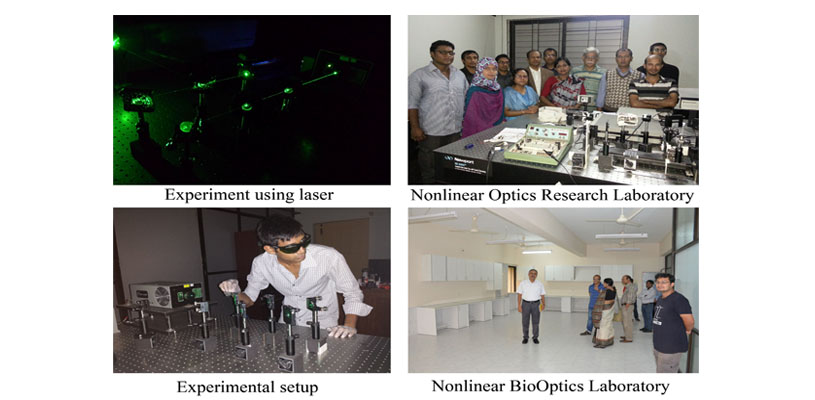
Nonlinear Optics Research
(i) Start of Research
The field of Nonlinear Optics started after the invention of lasers in 1961. It involves the study of intense laser light with materials. The presence of intense light in a medium results in optical modification of its properties leading to interesting phenomena and related applications. It was in 1996 that plans were first made to start research in this field in the Department of Physics at SUST. It was envisioned that expenses involved in setting up a Nonlinear Optics Laboratory would be feasible and not impossible in a public university.
(ii) Theoretical
To build up the theoretical background of the students interested in this field, courses were designed with an up to date syllabus. Books on Nonlinear Optics were made available for the students and theoretical courses were offered, at the undergraduate level, from 1997 in the Department of Physics at SUST. Advanced graduate level courses in Nonlinear and Photorefractive Optics, along with a course on Lasers, were soon added to the curriculum to enhance the understanding and theoretical foundation of the students interested in research in this area.
(iii) Experimental
A small grant was given by the Science Ministry of Bangladesh, in 1999, to start the experimental work. An Ar-Ion laser was procured and a home made optical table constructed to do the initial simple optical measurements. In the meantime, a search for funding for an optics laboratory had been initiated. It seemed like a golden opportunity when the University Grants Commission (UGC) announced in 2010 that proposals could be submitted for grants under the Higher Education Enhancement Program (HEQEP).
. Proposals were submitted from the Department of Physics for Academic Innovation Fund subprojects of HEQEP given from the Ministry of Education with the financial and technical support of the World Bank.
HEQEP Projects
(i) In the first call of the AIF subproject launched in May 2010 by the UGC, under Window 2, a research proposal was submitted for the study of the fundamental properties of nonlinear optical materials titled: “Optical Properties and Structure Analysis of Nonlinear Materials.”
The award of this subproject made a significant difference and made it possible to set up a very highly sophisticated, state of the art, nonlinear optics laboratory in the Department of Physics at SUST.
(ii) The UGC solicited proposals on University-Industry Research Collaboration under Windows 4 –Innovation Fund in September 2015. This was an attempt to build a strong and diverse academia-industry relationship. The NLO group submitted a proposal, emphasizing the applications side of the research and the knowledge acquired from experimentation in the already established Nonlinear Optics Research Laboratory. This proposal titled: “Innovative Biomarker Detection System Using Nonlinear Optics” led to the award of the 2nd HEQEP project to the Department of Physics, as the entity of the project.
Nonlinear Optics (NLO) Research Group:
Group Leader: Prof. Yasmeen Haque
Group Members:
Faculty:
Prof. Dr Syed Badiuzzaman Faruque, Prof. Susanta Kumar Das, Prof. Sharif. Md. Sharafuddin, Anock Somadder, Md. Enamul Hoque, Ponkog Kumar Das
Researcher (PhD, M. Phil, M S):
Manash Kanti Biswas, Mohammed Rumman Ahmed, Kallol Chakrabarty, Md Moiuddin Tasnim, Robi Kormokar, Mohamaya Deb, Ruma Das, Md. Rezaur Rahaman
Associate Members (Student):
A. K. M. Maruf Hossain, Sharmin Akter, Susmita Bhattacharjee
Laboratories under this group
(i) Nonlinear Optics Research Laboratory
This well-equipped Nonlinear Optics Research Laboratory, established under HEQEP, is presently one of the best equipped optics laboratories in the country. A strong research group, with faculty researchers and students, has been established. Students are working under different faculty members in completing their MS, MPhil and Ph.D degrees.
Expertise has been developed in the optical characterization of novel organic materials. The measurements of second and third order nonlinear effects using
Z-Scan, Thermal Lensing, Mach Zehnder Interferometer and Hyper Rayleigh Scattering techniques have resulted in numerous publications.
(ii) Nonlinear BioOptics Laboratory
The state of art Nonlinear Optics Research Laboratory encouraged the researchers of this laboratory to look at possible applications of the materials and skills developed for the characterization techniques. Applications oriented research activities resulted in the group being awarded another HEQEP grant, in 2016, to promote research under the University-Industry Research Collaboration.
This application based laboratory is the Nonlinear BioOptics Laboratory, which is being established with the hope of being one of a kind for doing Optical Biomarkers research.
Laboratory Facilities
(i) Nd:Yag Laser
(ii) Ar-Ion Laser
(iii) He-Ne and DPSS Lasers
(iv) Electronics Laboratory
(v) Workshop
(vi) Optical Table and Optical Components
(vii) Digital Oscilloscope
Rules to be maintained by all members
Access to this research facility is available for all, subject to the rules below:
(i) Having research association with the laboratory
(ii) Non Disclosure Agreement (NDA) signed
(iii) Multidisciplinary personnel associated with the project research activities